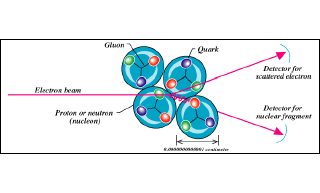Jefferson Lab Site Tour
How do scientists study quarks?
A sheet of aluminum foil is about 250,000 atoms thick. If you took one of those atoms and enlarged it so that it was the size of the earth, a quark inside the nucleus of that atom would be no larger than your fist. How can scientists possibly study something that small?
Scientists at Jefferson Lab use electrons to study quarks. They direct a beam of electrons at a sample of matter and observe how the electrons interact with it. Unfortunately, the scientists need very high energy electrons to be able to detect details small enough to allow them to 'see' quarks. A machine called an accelerator is used to produce a beam of electrons with the energy the scientists need.
Citation and linking information
For questions about this page, please contact Education Web Administrator.

